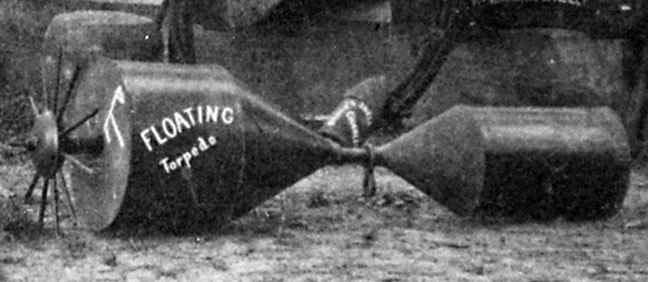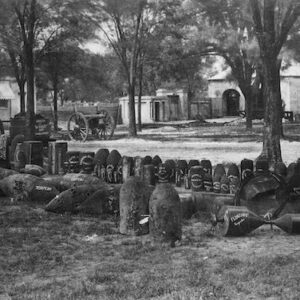Tag: floating torpedo
 Wikipedia says: In modern language, a “torpedo” is an underwater self-propelled explosive, but historically, the term also applied to primitive naval mines. These were used on an ad hoc basis during the early modern period up to the late 19th century. Early spar torpedoes were created by the Dutchman Cornelius Drebbel in the employ of King James I of England; he attached explosives to the end of a beam affixed to one of his own submarines and they were used (to little effect) during the English expeditions to La Rochelle in 1626.
Wikipedia says: In modern language, a “torpedo” is an underwater self-propelled explosive, but historically, the term also applied to primitive naval mines. These were used on an ad hoc basis during the early modern period up to the late 19th century. Early spar torpedoes were created by the Dutchman Cornelius Drebbel in the employ of King James I of England; he attached explosives to the end of a beam affixed to one of his own submarines and they were used (to little effect) during the English expeditions to La Rochelle in 1626.
An early submarine, Turtle, attempted to lay a bomb with a timed fuse on the hull of HMS Eagle during the American Revolutionary War, but failed in the attempt.
In the early 1800s, the American inventor Robert Fulton, while in France, “conceived the idea of destroying ships by introducing floating mines under their bottoms in submarine boats”. He coined the term “torpedo” in reference to the explosive charges with which he outfitted his submarine Nautilus. However, both the French and the Dutch governments were uninterested in the submarine. Fulton then concentrated on developing the torpedo independent of a submarine deployment. On 15 October 1805, while in England, Fulton put on a public display of his “infernal machine”, sinking the brig Dorothea with a submerged bomb filled with 180 lb (82 kg) of gunpowder and a clock set to explode in 18 minutes. However, the British government refused to purchase the invention, stating they did not wish to “introduce into naval warfare a system that would give great advantage to weaker maritime nations”. Fulton carried out a similar demonstration for the US government on 20 July 1807, destroying a vessel in New York’s harbor. Further development languished as Fulton focused on his “steam-boat matters”. During the War of 1812, torpedoes were employed in attempts to destroy British vessels and protect American harbors. In fact a submarine-deployed torpedo was used in an unsuccessful attempt to destroy HMS Ramillies while in New London’s harbor. This prompted the British Captain Hardy to warn the Americans to cease efforts with the use of any “torpedo boat” in this “cruel and unheard-of warfare”, or he would “order every house near the shore to be destroyed”.
Torpedoes were used by the Russian Empire during the Crimean War in 1855 against British warships in the Gulf of Finland. They used an early form of chemical detonator.
During the American Civil War, the term torpedo was used for what is today called a contact mine, floating on or below the water surface using an air-filled demijohn or similar flotation device. These devices were very primitive and apt to prematurely explode. They would be detonated on contact with the ship or after a set time, although electrical detonators were also occasionally used. USS Cairo was the first warship to be sunk in 1862 by an electrically-detonated mine. Spar torpedoes were also used; an explosive device was mounted at the end of a spar up to 30 feet (9.1 m) long projecting forward underwater from the bow of the attacking vessel, which would then ram the opponent with the explosives. These were used by the Confederate submarine H. L. Hunley to sink USS Housatonic although the weapon was apt to cause as much harm to its user as to its target. Rear Admiral David Farragut’s famous/apocryphal command during the Battle of Mobile Bay in 1864, “Damn the torpedoes, full speed ahead!” refers to a minefield laid at Mobile, Alabama.
Showing all 3 results


